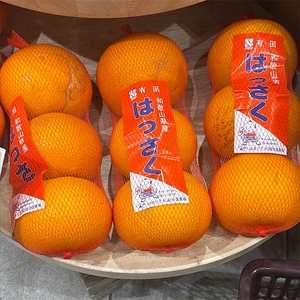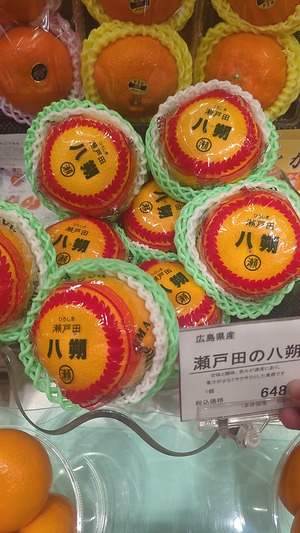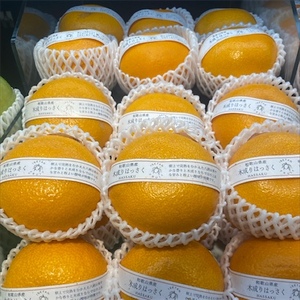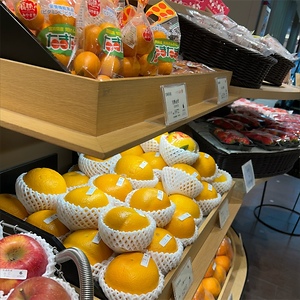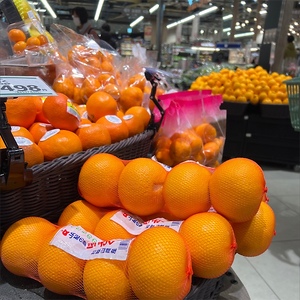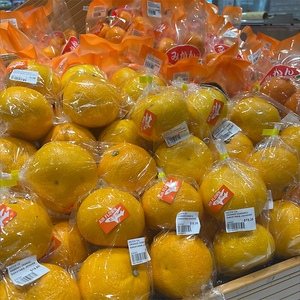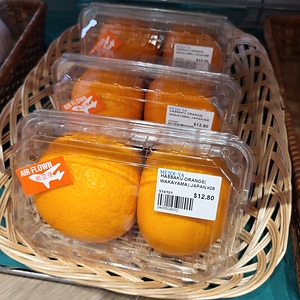

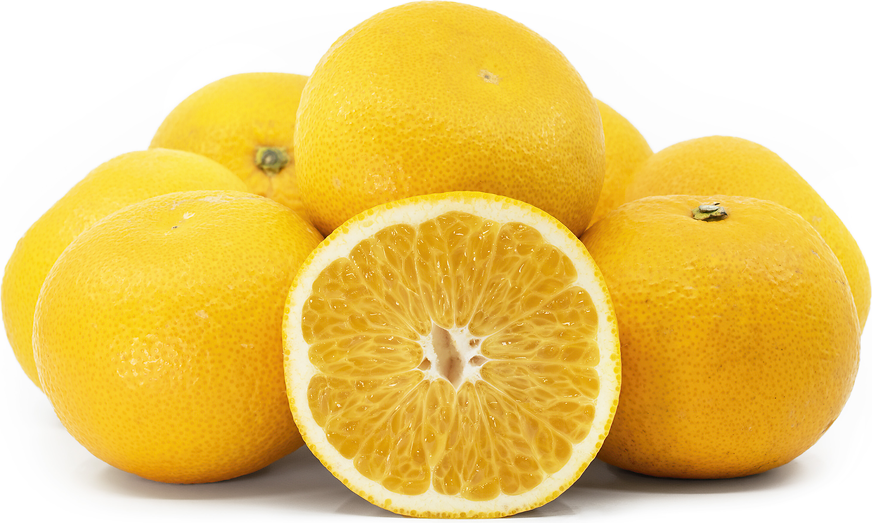
Hassaku Oranges
Estimated Inventory, lb : 0
Description/Taste
Hassaku oranges are a medium to large varietal, averaging 9 to 10 centimeters in diameter, and have a globular to oblate shape with a slightly flattened top and bottom. The rind is moderately thick, showcasing orange-yellow hues, and is covered in sunken oil glands, giving the surface a pebbled, textured, and coarse feel. Underneath the bumpy exterior, there is a defined layer of bitter and spongy, white pith that is somewhat adhered to the flesh, making the fruit difficult to peel by hand. The pale orange flesh is firm and divided into 10 to 11 segments by fibrous membranes. It is recommended to remove the membranes from the flesh as the membranes can contribute a bitter, sometimes unpleasant flavor. The flesh is also semi-aqueous, lightly fibrous, chewy, and filled with slender, cream-colored seeds, occasionally containing a hollow core at maturity. Hassaku oranges are aromatic and release an invigorating floral and citrusy scent when sliced. The flesh has balanced sugar and acidity levels, creating a complex blend of sweet, bitter, and sour flavors reminiscent of grapefruit, limes, and oranges.
Seasons/Availability
Hassaku oranges are available in the winter through early spring.
Current Facts
Hassaku oranges, botanically classified as Citrus hassaku, are a Japanese citrus variety belonging to the Rutaceae family. The aromatic fruits grow on compact, evergreen trees and were first discovered in Japan as a chance seedling in the late 19th century. Despite their orange descriptor, Hassaku oranges are not true oranges but are a hybrid variety. The exact parentage is unknown, but experts believe the fruits may have been developed from a pollination cross between a mandarin and pomelo. Hassaku oranges are specialty citrus cultivated on a small scale in Japan. The fruits are valued by citrus enthusiasts for their sweet and sour flavor and are mostly consumed fresh to savor the balanced blend of sugar and acidity. Hassaku oranges are also marketed as luxury citrus sold throughout Japan and exported to Southeast Asia, often given as gifts for celebratory occasions.
Nutritional Value
Hassaku oranges are a good source of fiber to regulate the digestive tract and vitamin C to strengthen the immune system while reducing inflammation. The fruits also provide folic acid to produce red blood cells, potassium to balance the fluid levels within the body, copper to maintain a healthy nervous system, and contain lower amounts of phosphorus and calcium.
Applications
Hassaku oranges have a bittersweet flavor suited mostly for fresh preparations. The variety has a thick rind that must be cut from the flesh, and the fibrous membranes are bitter, recommended to be peeled before consumption. Hassaku oranges are valued as a fresh eating citrus as they are juicy and provide a complex but balanced, sweet and sour flavor. The oranges are traditionally eaten straight, out of hand, and the peeled segments can be mixed into fruit salads, tossed into green salads, or stirred into grain bowls. Some consumers eat the oranges similarly to grapefruit, scooping out the flesh between the membranes. Hassaku oranges can also be layered into parfaits, blended into sorbet, or drizzled in chocolate as a healthy dessert. In Japan, it is believed that Hassaku oranges develop stronger bitter flavors when cooked, leading the fruits to be paired with sugary recipes to balance the taste. Hassaku oranges are popularly simmered into jams, jellies, and marmalade, or they can be incorporated into baked goods, candies, and other desserts. They can also be blended and frozen into a sorbet or pressed into juice to use as a flavoring for sodas, cocktails, and juice drinks. Beyond fresh uses, Hassaku oranges can be thinly sliced and dehydrated. The dried slices retain most of the fruit’s flavor and develop a chewy texture, used as an edible garnish over desserts and beverages or eaten as a tangy snack. Hassaku oranges pair well with vanilla, chocolate, white bean paste, herbs such as mint, basil, and rosemary, and spices including cloves, cinnamon, cardamom, and nutmeg. Whole, unopened Hassaku oranges will keep for a couple of days when stored in the refrigerator. It is recommended to use the fruits immediately for the best quality and flavor, as the oranges develop a bitter quality the longer they are stored.
Ethnic/Cultural Info
Hassaku oranges were the inspiration behind the mascot for the island of Innoshima in the Hiroshima Prefecture of Japan. Innoshima is the original discovery site of Hassaku oranges in the late 19th century, and the island has a temperate climate, allowing the citrus hybrid to flourish naturally. Hassaku orange trees line several streets throughout the island, and the island’s mascot, Hassa-Kun, is a man dressed in a yellow bodysuit resembling the rind of the Hassaku orange with a small leaf sprouting from his hood. The mascot is purposely styled after Hassaku oranges, as the mascot’s purpose is to raise awareness of the island’s notable features, such as agrotourism, to sample fresh Hassaku oranges. Innoshima island has also become famous for its Hassaku daifuku, a handmade confectionary found at Hassaku-ya in Ohamasaki Park. Kashihara, the owner of Hassaku-ya, started making daifuku when he was 50 years old after deciding to make a career change and apprentice a local daifuku maker on the island. Hassaku daifuku is made from scratch and uses 2 to 3 pieces of fresh Hassaku oranges, painstakingly peeled by hand to remove the bitter membranes. The citrus slices are then wrapped in glutinous rice and a white bean paste, creating a pleasantly sweet, creamy, subtly bitter, and sour dessert. When Kashihara began his journey as a daifuku maker, he traveled across Japan by truck to hand out samples of his daifuku to raise awareness of the specialty confectionary. His perseverance eventually paid off as the daifuku generated a buzz across Japan, leading food enthusiasts to travel to Innoshima to seek out the dessert. In the modern-day, Kashihara sells as many as 2,000 Hassaku daifuku in one day and continues to make the confectionery by hand.
Geography/History
Hassaku oranges were discovered growing as a chance seedling near the Jodo Temple on the island of Innoshima in Hiroshima Prefecture, Japan, in the late 19th century. The parentage of the citrus is unknown, but experts hypothesize that the variety may be a cross between a mandarin and pomelo, with the pomelo being the predominant parent. Hassaku oranges were first recorded in 1860, but the variety remained relatively unknown until they were selected for commercial cultivation in 1925. At the beginning of commercial production, Hassaku oranges were mostly grown on Innoshima Island, later expanding into other prefectures around 1960. The citrus hybrid was also sent to the Citrus Variety Collection in Riverside, California, in 1984, for research and study, but the tree remained localized to the collection and was not chosen for propagation. Today Hassaku oranges are primarily grown in the Wakayama Prefecture and are cultivated on a smaller scale in Tokushima, Hiroshima, and Ehime Prefectures. When in season, the citrus is sold through specialty grocers, retailers, and growers in Japan. Hassaku oranges are also exported to countries throughout continental Asia. The Hassaku oranges featured in the photograph above were sourced from Meidi-Ya Supermarket at the Millenia Walk in Singapore. The oranges were air-flown in from the Wakayama Prefecture in Japan.



